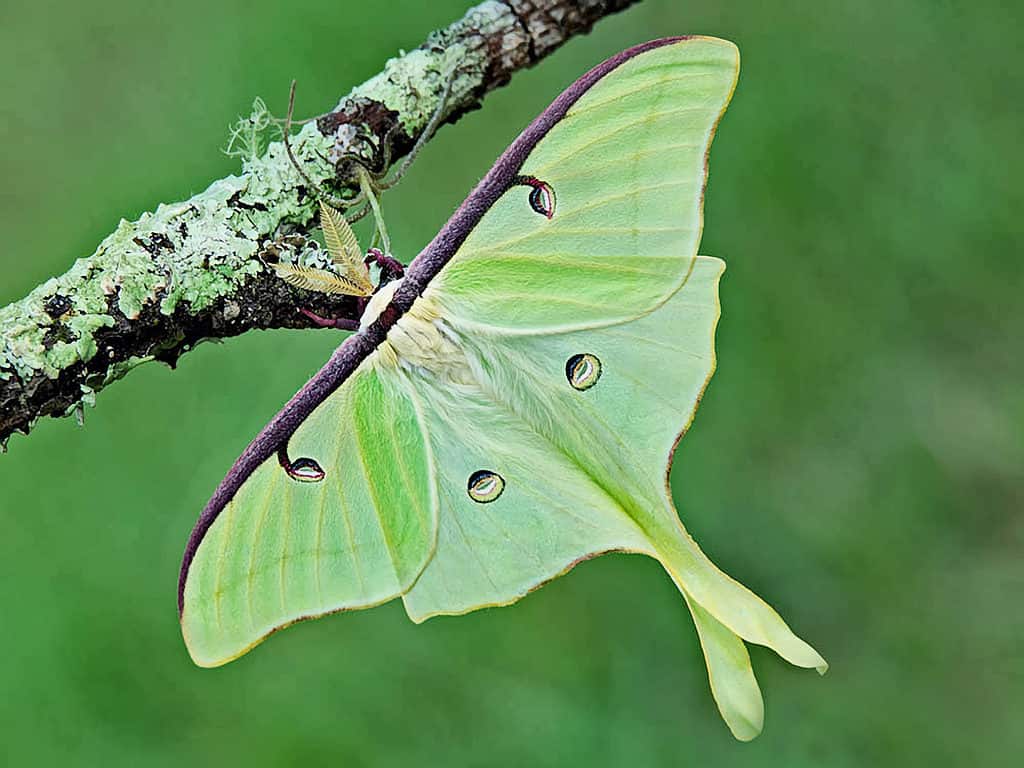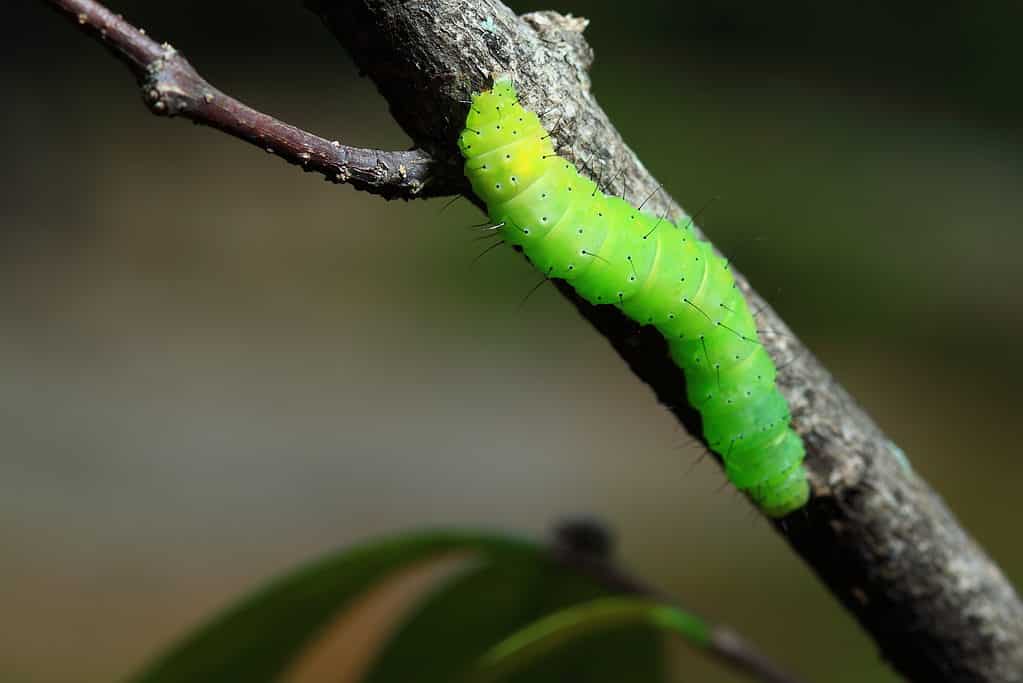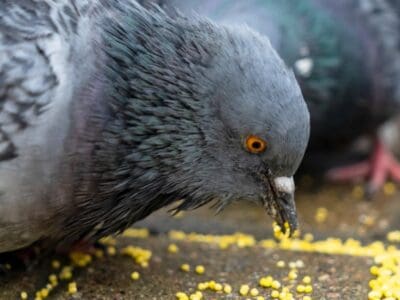Luna Moth
Actias luna
The luna moth had its own U.S. postage in 1987.
Advertisement
Luna Moth Scientific Classification
- Kingdom
- Animalia
- Phylum
- Arthropoda
- Class
- Insecta
- Order
- Lepidoptera
- Family
- Saturniidae
- Genus
- Actias
- Scientific Name
- Actias luna
Read our Complete Guide to Classification of Animals.
Luna Moth Conservation Status

Luna Moth Facts
- Prey
- N/A
- Main Prey
- N/A
- Name Of Young
- N/A
- Group Behavior
- Solitary except during mating season
- Fun Fact
- The luna moth had its own U.S. postage in 1987.
- Estimated Population Size
- undetermined
- Biggest Threat
- habitat loss
- Most Distinctive Feature
- translucent green color
- Distinctive Feature
- large size
- Other Name(s)
- American Moon Moth
- Gestation Period
- 3 weeks
- Temperament
- docile
- Wingspan
- 3-5 inches
- Training
- N/A
- Optimum pH Level
- N/A
- Incubation Period
- N/A
- Age Of Independence
- birth
- Age Of Fledgling
- N/A
- Average Spawn Size
- N/A
- Litter Size
- N/A
- Habitat
- Luna moths live in the deciduous woodlands and forests of North America, specifically in the Eastern regions
- Predators
- Bats and birds
- Diet
- Herbivore
- Average Litter Size
- 200-400
- Lifestyle
- Nocturnal
- Favorite Food
- N/A
- Type
- Actias luna
- Common Name
- luna moth
- Special Features
- Moon like eyespots on its hindwing; large size
- Origin
- North America
- Number Of Species
- 250
- Location
- North America
- Slogan
- N/A
- Group
- eclipse
- Nesting Location
- leaf debris
- Age of Molting
- various stages during their larval stage.
Luna Moth Physical Characteristics
- Color
- Green
- Skin Type
- Exoskeleton
- Lifespan
- 1 week
- Weight
- 0.06-0.1 ounce
- Height
- 0,25-0.5 inches
- Length
- 1-2 inches
- Age of Sexual Maturity
- 1 day
- Age of Weaning
- N/A
- Venomous
- No
- Aggression
- Low
View all of the Luna Moth images!
The luna moth (Actias luna) is large and green and native to North America. It is known for its long, curved tail and large, translucent wings. The luna moth is considered one of the most beautiful moths in North America. They are active at night and are often drawn to lights. It is a member of the Saturniidae family, a nod to the eyespots of concentric rings on its hindwings that resemble the rings of the planet Saturn. Keep reading to learn more about Actias luna.
Five Fresh Facts about Luna Moths
- Luna moths are among the largest moths in North America, with wingspans of up to 5 inches!
- Adults have vestigial mouths. They cannot eat. Their sole purpose is to mate. And then they die.
- The luna moth had its own U.S. postage in 1987.
- They were originally called phalena plumata daudata, meaning brilliant feather tail.
- Moths smell with their feet.
Luna Moth: Scientific Name
The scientific name for the luna moth is Actias luna. Its Latin name translates to active moon, and it’s true that they are most active at night. However, the luna moth gets its name from the moon-like spots on its hindwings. The family name Saturniidae refers to the false eyes or eyespots of concentric rings, that resemble the rings of the planet Saturn.
Luna Moth: Appearance
The Luna moth is a large, green moth found in the Eastern part of North America. They typically weigh between 0.06 and 0.1 ounces (1.7 to 2.8 grams) and have wingspans of up to 5 inches. Its wings are a translucent pale green color. The hindwings have a long tail-like extension. The body is also green and has a small, reddish head. They have false eyes on their hindwings. These false eyes, also known as ocelli, (singularly, ocellus), deter predators by making the moth appear larger and more intimidating. The ocelli are typically circular in shape and have a dark center, mimicking the appearance of a real eye. These ocelli are also why the moth is called a luna moth. It is thought that their ocelli resemble moons.

A luna moth’s wings are a translucent pale green color.
©Amy C Anderson/Shutterstock.com
Behavior
Luna moths have short lifespans in which they do little more than mate. The females lay eggs, and then they die. That’s it. To attract a mate, females release pheromones from specialized structures called scent glands, located on the sides of their abdomens. These pheromones attract males from distances of up to 6 miles away! Males also have scent glands that they use to detect the pheromones of females. These scent glands are located on the antennae of the males. The moths tend to mate after midnight. The female lays her eggs the following night, and for several nights thereafter. Females lay between 200-400 eggs on the underside of leaves on walnut, sweet gum, persimmon, and white birch trees.
Habitat
Luna moths live in the deciduous woodlands and forests of North America, specifically in the Eastern regions. They also live in Canada and Mexico. Adults typically live for about one week and do not eat during this time, as they have vestigial, or small underdeveloped mouths. While in their larval stage, they feed on the leaves of trees such as hickory, walnut, and sweetgum, but as adults, they survive on the energy reserves from their caterpillar stage.
Diet
As touched on previously, luna moths do not eat. They instead rely on energy stores from their larval stage.
Predators
Luna moths have a number of natural predators. However, number one among them is bats. Chiefly due to their nocturnal nature, luna moths encounter more bats. Crepuscular birds, such as sparrows and robins, will eat adult moths. Small mammals, like squirrels and mice, may also consume them in their larval stage.

Small mammals, like squirrels and mice, may consume luna moths in their larval stage.
©Skynavin/Shutterstock.com
Luna Moth: Threats
A primary threat to luna moths is habitat loss. They rely on specific types of trees, such as sweet gum and persimmon, for their survival. As these trees are cut down for development or other human activities, the moths lose their breeding and feeding grounds.
Pesticide and herbicide use can also negatively affect these fascinating creatures. Pesticides intended to control other insect populations can also kill caterpillars, adults, and their food sources!
Habitat preservation and reduction in pesticide usage are crucial to ensure the survival of luna moths.
Conservation Status
The Luna moth is not currently listed as endangered or threatened by the International Union for Conservation of Nature (IUCN) or the U.S. Fish and Wildlife Service. However, populations of the species have been declining in recent years. Some states have listed them as a species of special concern or have designated them as a protected species. Efforts to protect and conserve the Luna moths include habitat restoration, pesticide/herbicide reduction, and public education about the importance of these moths in the ecosystem.
Luna Moth: Lifecycle
The Luna moth goes through four stages in its lifecycle: egg, larva (caterpillar), pupa, and adult.
1. The female lays her eggs on the leaves of the host plant.
2. The eggs hatch into small, green caterpillars that feed on the leaves of the host plant.
3. The caterpillars go through several molts (shed their skin) as they grow larger.
4. When they are finished growing the caterpillars spin a cocoon, typically attached to a twig or leaf, and pupate inside.
5. After approximately three weeks, the metamorphosed moth emerges from its cocoon. This typically occurs in the morning to give the moth’s wings time to dry prior to taking their first night flight. Adults live for a week or less.
The Luna Moth in Literature
Luna moths have been written about in a variety of genres, often as symbols of beauty, mystery, and transformation. In literature, it is also often used to reflect the fleeting nature of life. In the poem The Luna Moth by Emily Dickinson, it is described as a white-winged prophet of the air that flits like a fragment of the moon. The novel To Kill a Mockingbird by Harper Lee features a scene in which the character Scout Finch watches a moth flying around her porch light as she reflects on the transience of all things. In the poem The Moths by Margaret Atwood, the creature is a central figure, representing the fleeting nature of life and the inevitability of death.
Luna Moth Movie Night
Interested in seeing a luna moth? They only come out at night – and relatively late at night, for that matter. Put on the coffee, because the best time to catch a glimpse of these magnificent creatures is between midnight and 1:00 AM! Optimum viewing will require a couple of white sheets and a couple of bright lights. Hang one sheet across a clothesline or similar structure. Place the second sheet on the ground under the first sheet. This is for ease of viewing any moths that land on the ground, and also to avoid accidentally stepping on them. Shine the lights on the sheet. Voila! You are now prepared to see these fascinating moths.
Up Next:
View all 98 animals that start with LLuna Moth FAQs (Frequently Asked Questions)
is it true that Luna Moths do not have mouths?
No. Adult luna moths have vestigial mouths. However, vestigial means underdeveloped or not functional. So while luna moths do have mouths, they cannot use them to eat. Instead, adult luna moths rely on energy stores from their larval (caterpillar) stage.
How did the Luna Moth get its name?
The luna moth is named for the false eyes on its hindwings which are thought to look like the Earth’s moon. These false eyes are called ocelli, (singularly, ocellus) and are used to deter predators by making the moth appear larger and more intimidating.
What is the luna moth's conservation status?
The Luna moth is not currently listed as endangered or threatened by the International Union for Conservation of Nature (IUCN) or the U.S. Fish and Wildlife Service. However, populations of the species have been declining in recent years. Some states have listed the Luna moth as a species of special concern or have designated it as a protected species.
What is the best time to see a luna moth?
Put on the coffee, because the best time to view luna moths is between midnight and 1:00 AM! For best results hang up a white sheet and shine a bright light on it.
What is the luna moth's primary predator?
Thanks to their nocturnal nature, luna moths are often preyed upon by bats. Their long hindwings are thought to be an adaption that throws off the bats’ sense of echolocation.
Thank you for reading! Have some feedback for us? Contact the AZ Animals editorial team.
Sources
- ufl.org, Available here: https://entnemdept.ufl.edu/creatures/misc/moths/luna_moth.htm
- fllt.org, Available here: https://www.fllt.org/goddess-of-the-moon-the-life-history-of-the-luna-moth/
- wikipedia.org, Available here: https://en.wikipedia.org/wiki/Luna_moth

















